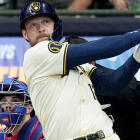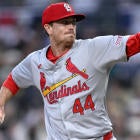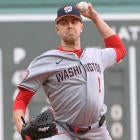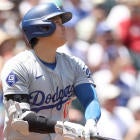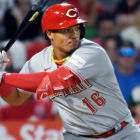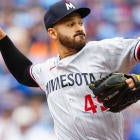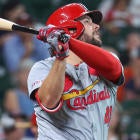Different owners from the Tout Wars expert league will be submitting a guest Fantasy Baseball column to CBSSports.com each week. This week's columnist, Cory Schwartz, writes for MLB.com, and has been in the Tout Wars NL-only league since 2004.
By Cory Schwartz
The 2008 season is my 20th of competing in Fantasy Baseball leagues, during which I've played in countless formats: mixed and non-mixed, drafts and auction, keepers and single-season, Rotisserie, Head-to-Head, simulations -- you name it. And while I won't claim to have won every single league in which I've competed, I have won more than my share of Yoo-Hoo showers.
For all that success, I've never been close to the top spot in Tout Wars, peaking at third place in my debut in 2004. The players on the field are the same ones as in my other leagues, and it's not like Tout -- a single-season NL-only auction league -- is an unfamiliar format. So why haven't I won? And why do they keep inviting me?
Tout Wars requires the complete range of Fantasy Baseball skills, so as I look back over the season, what skill is lacking that has prevented me from making a better showing? What can I learn from my mistakes?
The best place to start is always at the beginning, but a baseball season is a living thing -- your preseason preparation should begin even before the previous season ends, as September call-ups and prospects establish their credentials for the next season. The best Fantasy players I know -- think of guys like Jason Grey and Lenny Melnick -- are the hardest-working; they are never caught without the latest information on any player or scenario, from the winter leagues into spring training. Is this pitcher working on a new pitch? Did this hitter have offseason Lasik surgery or switch to a macrobiotic diet? Is this player's organization dissatisfied with his work ethic, or perhaps enamored with an unheralded minor leaguer who might surprise?
I'm not blessed with the opportunity to spend all of my time at the ballpark talking to players and coaching staffs, but I read local newspapers online, check the club sites on MLB.com and MiLB.com (shameless plug!) and faithfully check spring training box scores. Often such information can be noise, but if it relates to a player's health or opportunity, I take it seriously. Statistical analysis can certainly point towards players who are on the rise or on the decline, but managerial tendencies and roster construction can play a big part in determining who gets to make good on those expectations.
After doing my homework this winter I was convinced that the Diamondbacks were committed to Justin Upton in right field, so I was confident in spending $13 to acquire him. I picked up Chris Perez for a dollar in the endgame because I expected the Cardinals to struggle and give him a shot to win the closer job in the second half of the season, an expectation that could well pay off nicely. However, I also spent a dollar on Matt Antonelli expecting him to hit his way into taking Tadahito Iguchi's job, but with a .168 average so far, Antonelli won't be seeing the majors any time soon.
Still, it's not good enough to say "Chase Utley will be good this year" or "Ryan Howard can mash", both of which I did in the draft, and spent the money to back up those beliefs. All of the subjective observations and information gathered during the offseason and spring training have to be translated into real numbers, representing not only expectations but risk and probability.
It's not sufficient to simply pencil in 35 saves for Kerry Wood because he's the Cubs' closer, or 17 wins for Tim Lincecum because he's the Giants' ace. What if Wood gets injured or Carlos Marmol or Bob Howry outpitches him to claim the closer job? What if the precocious Lincecum's command regresses or he doesn't get sufficient offensive or bullpen support from his rebuilding Giants teammates? Expectations have to be realistic, and then dollars have to be budgeted to acquire those stats.
The budget you set has to match your in-season strategy, too. The plan is to draft a team that you can manage all season, not just one that looks good on paper after your $260 is all spent.
This is where I get myself into trouble: In-draft budget management is all about balancing discipline with the need to adjust to trends. Spend your money too quickly -- as I may well have by nabbing Utley ($37), Howard ($36), Ryan Braun ($36) and Russell Martin ($26) in the early going -- and you won't have that extra dollar to win a player you want later in the draft. But hold back for too long and you may be forced to overpay for second-rate talent later in the draft, as I did in particular with Khalil Greene ($18) and Mike Jacobs ($17). Personally, I find starting pitchers to be highly unpredictable and unreliable, so I tend to avoid them as much as possible on Draft Day. Plus, a few decent starters can be acquired inexpensively in free agency during the season, unlike closers or big-time offensive players, who will go for premium dollars. Still, it's realistic to compete in a deep non-mixed league like Tout Wars without at least a couple of strong options, so I try to focus on younger pitchers with good strikeout rates, and when those are gone, I look for those likely to put up low WHIPs on good teams, which should mean a few more wins to offset the low strikeout totals.
This year, I spent $18 on Brett Myers as my top starter, thinking he'd make a smooth transition back to the rotation and pick up plenty of wins and strikeouts. I also picked up Adam Wainwright for $15, liking his chances to improve in his second full year in the Cardinals rotation, and Hiroki Kuroda for $7, figuring that he'd enjoy a solid season his first time through the league. Unfortunately, my end-of-rotation gambles this year were ill-chosen at best, horrendous at worst: Barry Zito ($6), Odalis Perez ($1) and Jason Marquis ($1). Myers' slow start, combined with my lack of quality depth, has resulted in season-long struggles in wins, WHIP and ERA. Maintain discipline in your player choices or face the consequences!
Since I'm generally bargain-hunting after my top two or three starters, I try to spend more on a deep offense, with an emphasis on power and incremental speed. I'd rather have a handful of guys who can each get some steals, rather than paying for a one-category specialist like a Juan Pierre. The advantage of speedsters is that they can single-handedly control a category for you, but they come with a greater risk -- a pulled hamstring or calf can bury the player's value.
I built a monster offensive core this season, and then complemented it with a few decent $1 options and waiver wire pickups. Howard's slow start has dragged down my batting average, and neither Braun, Martin nor Upton have provided the speed I thought they would, but I'm leading the league in homers and RBI. Plus, I was able to deal Jacobs for badly-needed bullpen help -- more on that later.
Finally, I like a deep bullpen of power arms. Since I'm not going to have a great rotation, I need to offset that with a group of relievers who can rack up the saves, add plenty of strikeouts, and help control the ERA and WHIP. I need at least one ace closer and a solid secondary reliever, and if the dollars break right on Draft Day, I might try to get a second bargain bin closer to chip in another 20 or so saves.
This is another area where I failed to make the necessary adjustments during the draft. Most of the closers I liked went for only a dollar or two more than I was willing to spend, but instead of spending the extra dollar, I held out for a bargain and not only didn't get one, I got Chad Cordero -- a guy I didn't like or want -- at $18, when I could've had Francisco Cordero for only one dollar more had I managed my dollars more wisely. In-draft adjustments are critical.
In addition to whiffing on my closer selection, I also failed to build sufficient depth to offset my weak starting pitching. I wasn't able to land Jonathan Broxton or Heath Bell or any of the other top-quality setup men, managing only dollar pickups of Kevin Hart, Scott Proctor and Wil Ledezma. This is where the picks of Greene and Jacobs were so painful, because they burned extra dollars I could've used to build a better bullpen and a more well-rounded team.
No matter the circumstances, though, it's almost impossible to emerge from the draft without a few weaknesses, so working the free-agent wire and trade market are critical to repairing holes. The Jacobs-for-Brian Wilson deal helped patch my bullpen woes without costing me points in the power categories, and pickups like Reed Johnson and Jesus Flores have helped patch offensive holes.
After 10 weeks this season I'm stuck in 8th place, within a reasonable distance of fourth and even a realistic climb to second. I expect to climb in the second half as Howard, Myers and Cordero return to form, and I may even make a big charge in saves if Cordero and Perez can combine with Wilson to give me three closers. Still, it's probably too late to catch the runaway train engineered by defending champion Mike Lombardo of Wise Guy Baseball.
Barring a miraculous turn of events, victory will once again elude me in my fourth season of Tout Wars. I've still got a lot left to learn.
- Tout Wars main website
- Tout Wars: Mixed Standings and Rosters
- Tout Wars: AL-only Standings and Rosters
- Tout Wars: NL-only Standings and Rosters
You can e-mail Mr. Schwartz a question or a comment about this column to DMFantasyBaseball@cbs.com. Be sure to put "Attn: Tout Wars" in the subject field. Please include your full name, hometown and state. Be aware, due to the large volume of submissions received, we cannot guarantee personal responses to all questions.








